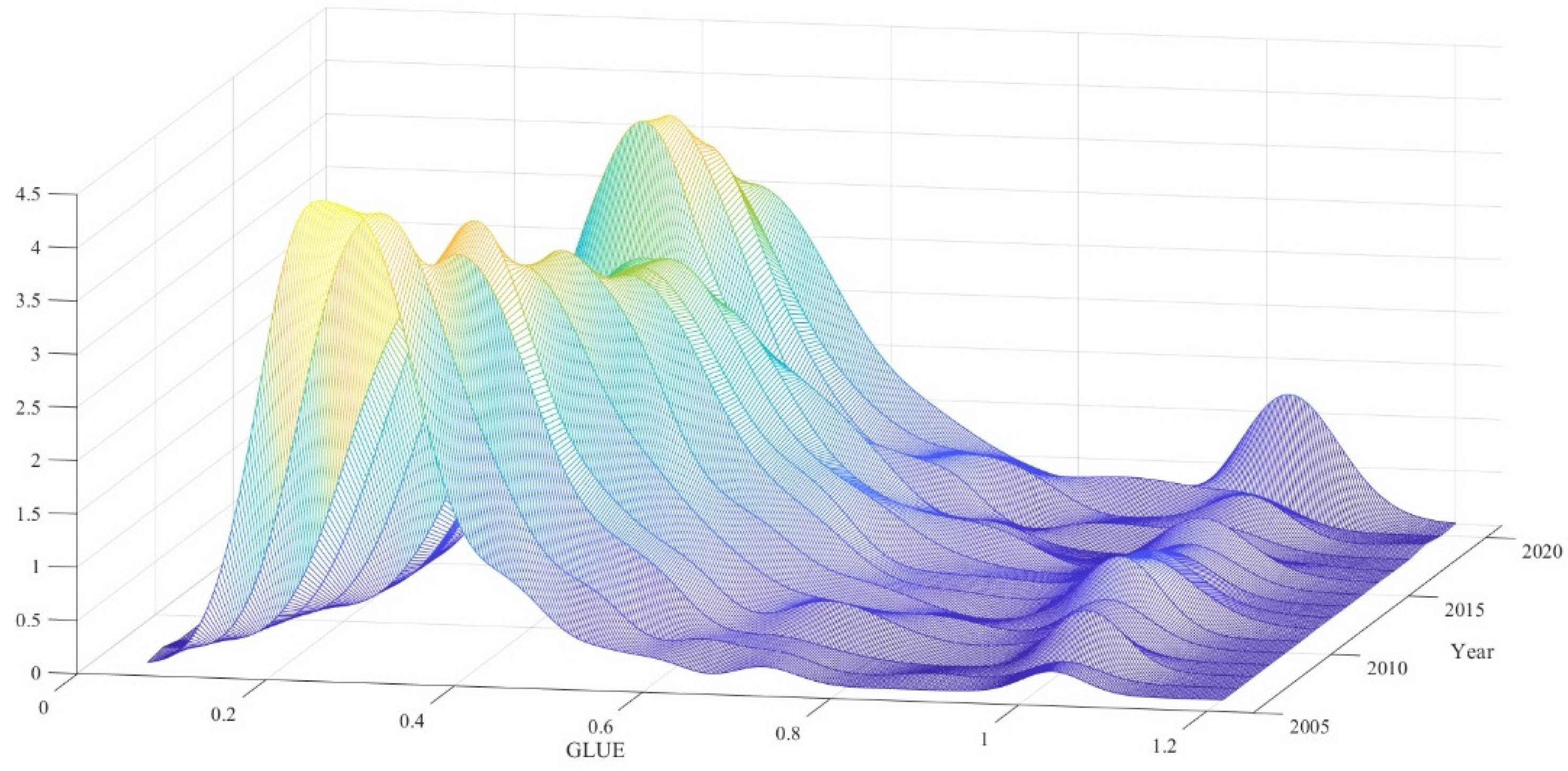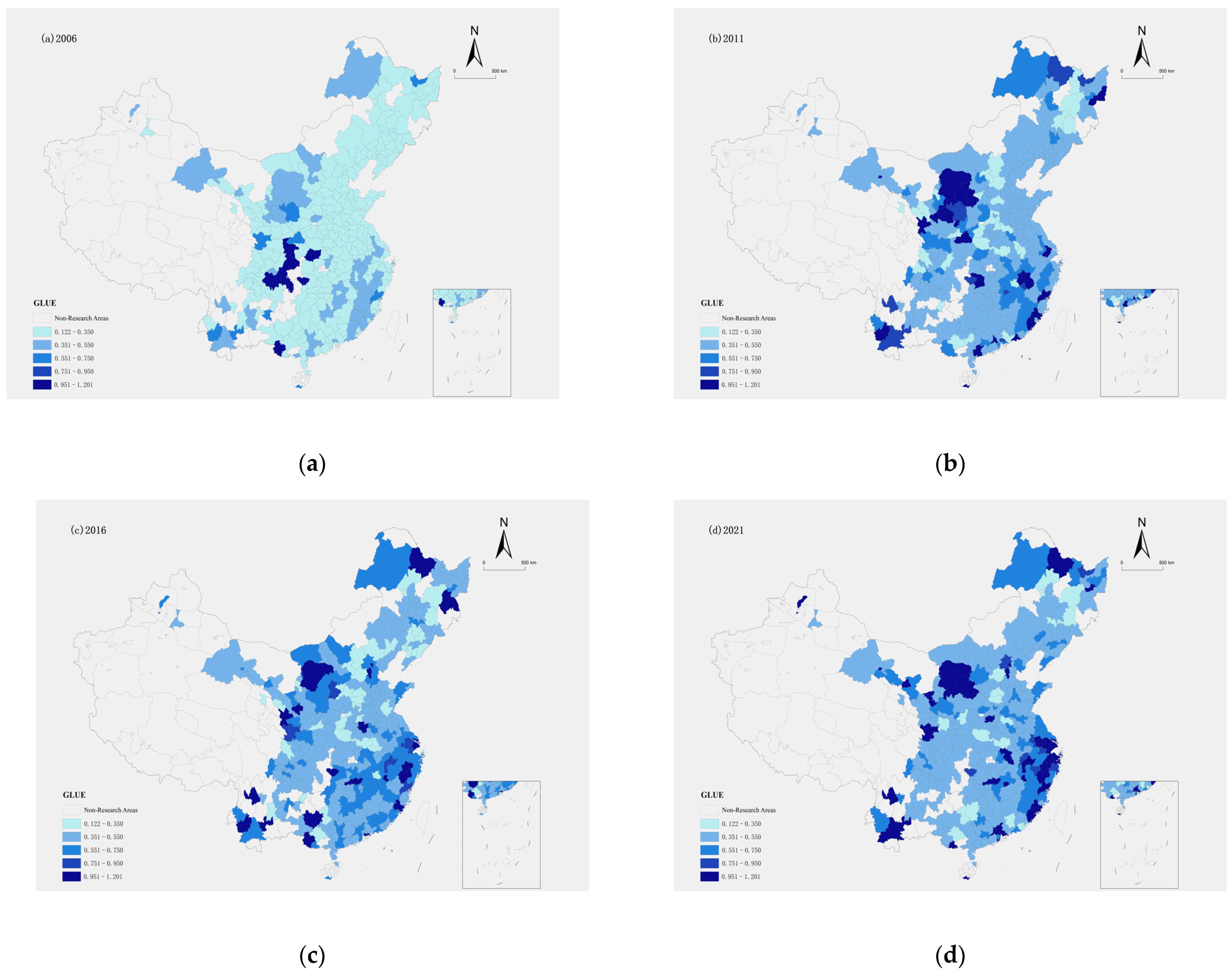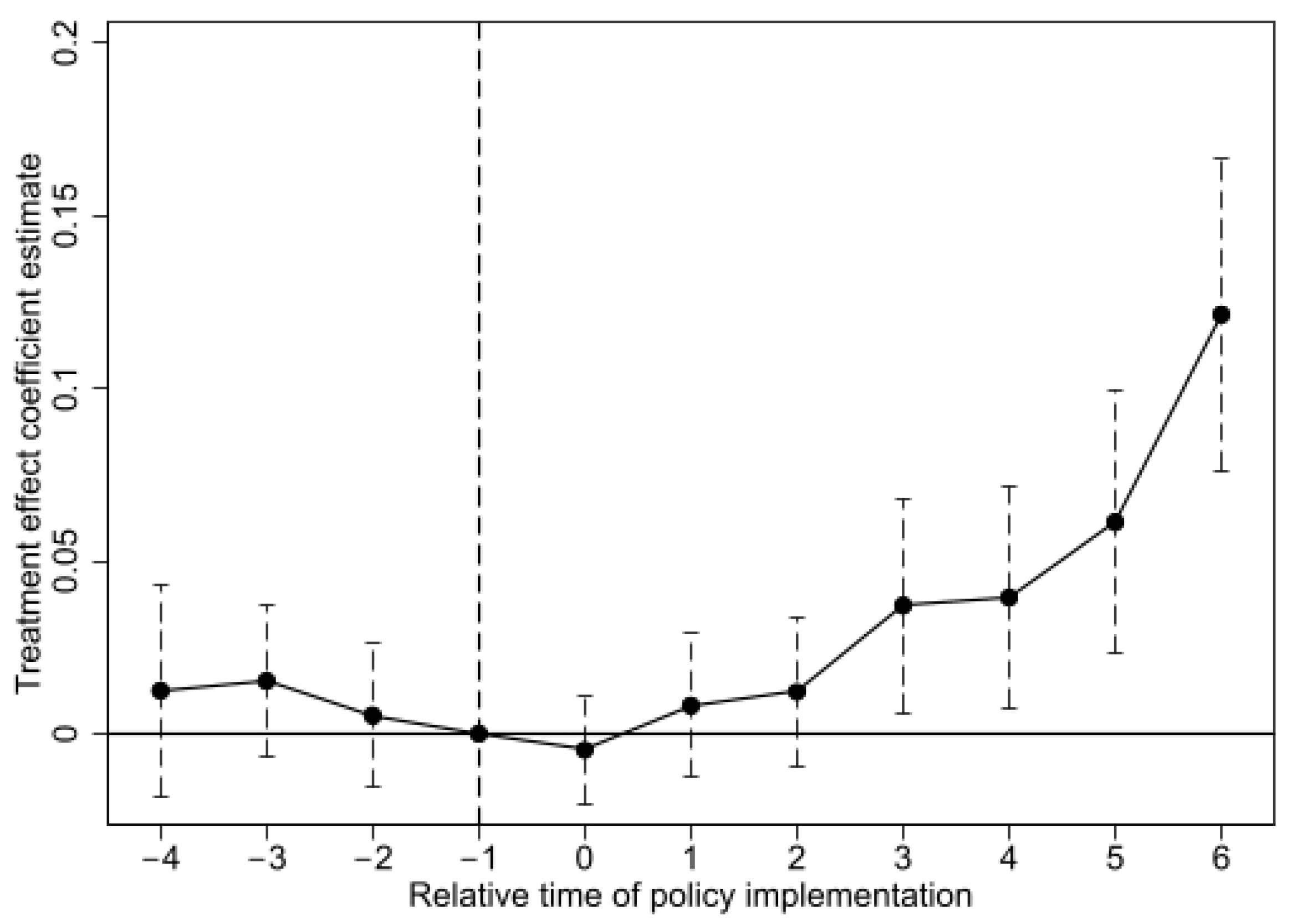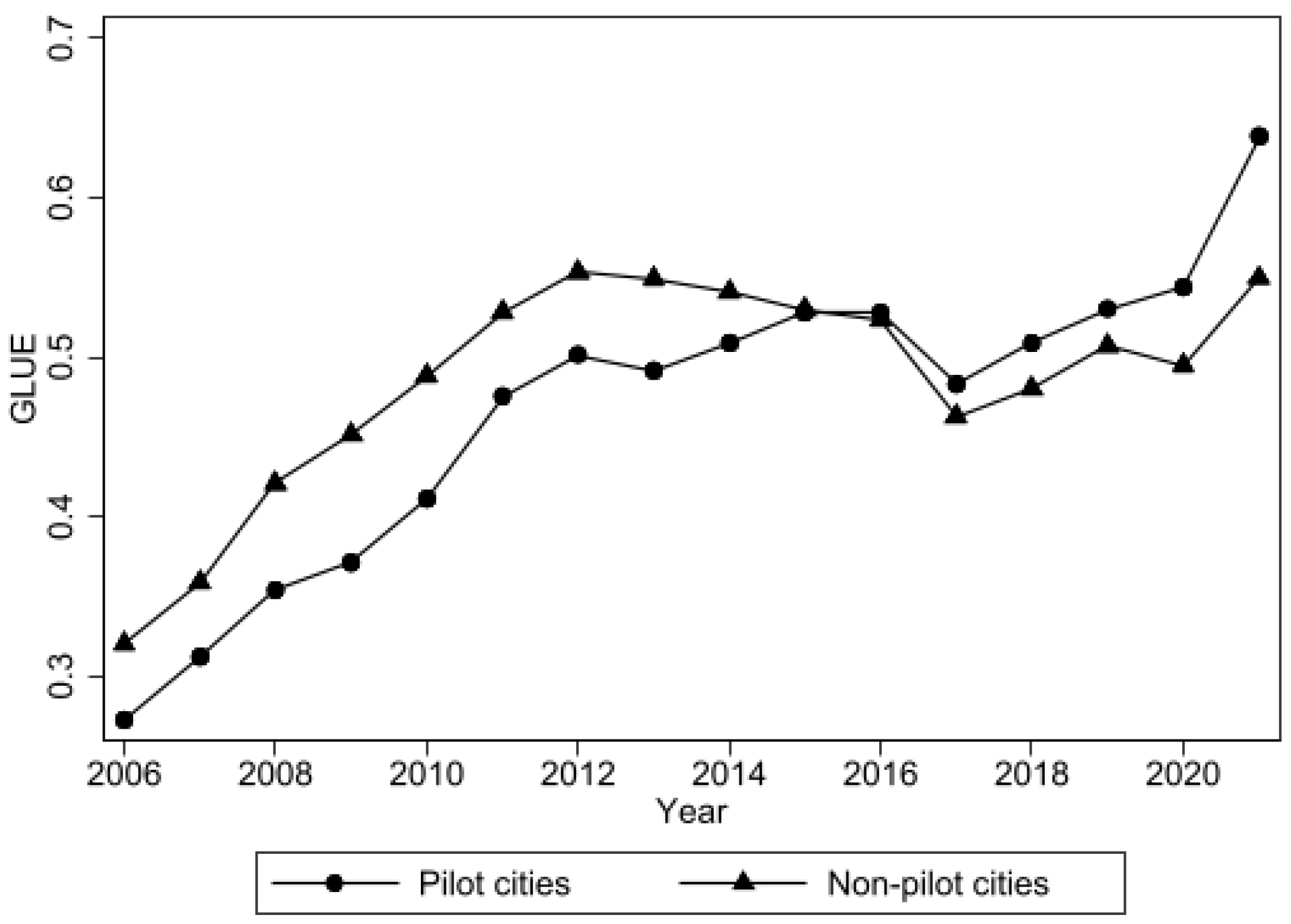How Do Innovation-Driven Policies Affect Urban Green Land Use Efficiency? Evidence from China’s Innovative City Pilot Policy
Abstract
1. Introduction
2. Theoretical Examination and Research Hypotheses
2.1. The Effects of ICPP on GLUE
2.2. Mediating Mechanism Analysis of the Impact of ICPP on GLUE
2.2.1. Urban Sprawl Effect
2.2.2. Agglomeration Effect
3. Materials and Methods
3.1. Models
Baseline Model
3.2. Variables
3.2.1. Explained Variable
3.2.2. Core Explanatory Variable
3.2.3. Control Variables
3.2.4. Mechanism Variables
3.3. Data Resource
4. Results
4.1. The Spatial–Temporal Evolution Description of GLUE
4.2. Results of the Baseline Model
4.2.1. Parallel Trend Test
4.2.2. Benchmark Regression
4.3. Robustness Test
4.3.1. Placebo Test
4.3.2. Heterogeneous Treatment Effects
4.3.3. Accounting for Omitted Variable Bias
4.3.4. Other Robustness Tests
4.4. Heterogeneity Analysis
4.4.1. Geographical Location Heterogeneity
4.4.2. Environmental Concerns Heterogeneity
4.4.3. Market Characteristics Heterogeneity
5. Mechanism Analysis
6. Discussion and Conclusions
6.1. Conclusions
6.2. Policy Recommendations
6.3. Shortcomings and Prospects
Author Contributions
Funding
Data Availability Statement
Conflicts of Interest
References
- Wang, S.; Yang, C.; Li, Z. Spatio-Temporal Evolution Characteristics and Spatial Interaction Spillover Effects of New-Urbanization and Green Land Utilization Efficiency. Land 2021, 10, 1105. [Google Scholar] [CrossRef]
- Tan, S.; Hu, B.; Kuang, B.; Zhou, M. Regional Differences and Dynamic Evolution of Urban Land Green Use Efficiency within the Yangtze River Delta, China. Land Use Policy 2021, 106, 105449. [Google Scholar] [CrossRef]
- He, S.; Yu, S.; Li, G.; Zhang, J. Exploring the Influence of Urban Form on Land-Use Efficiency from a Spatiotemporal Heterogeneity Perspective: Evidence from 336 Chinese Cities. Land Use Policy 2020, 95, 104576. [Google Scholar] [CrossRef]
- Liu, Y.; Long, H.; Li, T.; Tu, S. Land Use Transitions and Their Effects on Water Environment in Huang-Huai-Hai Plain, China. Land Use Policy 2015, 47, 293–301. [Google Scholar] [CrossRef]
- Tan, Y.; Xu, H.; Zhang, X. Sustainable Urbanization in China: A Comprehensive Literature Review. Cities 2016, 55, 82–93. [Google Scholar] [CrossRef]
- Song, Y.; Yeung, G.; Zhu, D.; Xu, Y.; Zhang, L. Efficiency of Urban Land Use in China’s Resource-Based Cities, 2000–2018. Land Use Policy 2022, 115, 106009. [Google Scholar] [CrossRef]
- Hu, W.; Li, Z.; Chen, D.; Zhu, Z.; Peng, X.; Liu, Y.; Liao, D.; Zhao, K. Unlocking the Potential of Collaborative Innovation to Narrow the Inter-City Urban Land Green Use Efficiency Gap: Empirical Study on 19 Urban Agglomerations in China. Environ. Impact Assess. Rev. 2024, 104, 107341. [Google Scholar] [CrossRef]
- Chava, S.; Oettl, A.; Subramanian, A.; Subramanian, K.V. Banking Deregulation and Innovation. J. Financ. Econ. 2013, 109, 759–774. [Google Scholar] [CrossRef]
- Aruta, G.; Ascione, F.; Bianco, N.; Mauro, G.M. Incentive Policies for Building Energy Retrofit: A New Multi-Objective Optimization Framework to Trade-off Private and Public Interests. J. Clean. Prod. 2025, 498, 145142. [Google Scholar] [CrossRef]
- Fan, H.; Li, Z.; Duan, Y.; Wang, B. Incentive Policy Formulation for China’s Electric Vehicle Market: Navigating Pathways to Sustainable Mobility with a Green Premium Analytical Model. Energy Policy 2025, 202, 114610. [Google Scholar] [CrossRef]
- Gonzalez Hernandez, S.; Kirchofer, A. Incentivizing Hydrogen: A Perspective Review of Lifecycle Analysis Meth odology Disparities Affecting Hydrogen Incentives in Policy Frameworks. Energy Clim. Change 2025, 6, 100172. [Google Scholar] [CrossRef]
- Wang, Z.; Chen, J.; Zheng, W.; Deng, X. Dynamics of Land Use Efficiency with Ecological Intercorrelation in Regional Development. Landsc. Urban Plan. 2018, 177, 303–316. [Google Scholar] [CrossRef]
- Zhou, Y.; Lu, Y. Spatiotemporal Evolution and Determinants of Urban Land Use Efficiency under Green Development Orientation: Insights from 284 Cities and Eight Economic Zones in China, 2005–2019. Appl. Geogr. 2023, 161, 103117. [Google Scholar] [CrossRef]
- Tone, K. A Slacks-Based Measure of Super-Efficiency in Data Envelopment Analysis. Eur. J. Oper. Res. 2002, 143, 32–41. [Google Scholar] [CrossRef]
- Zhu, X.; Zhang, P.; Wei, Y.; Li, Y.; Zhao, H. Measuring the Efficiency and Driving Factors of Urban Land Use Based on the DEA Method and the PLS-SEM Model—A Case Study of 35 Large and Medium-Sized Cities in China. Sustain. Cities Soc. 2019, 50, 101646. [Google Scholar] [CrossRef]
- Wang, P.; Shao, Z.; Wang, J.; Wu, Q. The Impact of Land Finance on Urban Land Use Efficiency: A Panel Threshold Model for Chinese Provinces. Growth Change 2021, 52, 310–331. [Google Scholar] [CrossRef]
- Zhou, G.; Xu, H.; Jiang, C.; Deng, S.; Chen, L.; Zhang, Z. Has the Digital Economy Improved the Urban Land Green Use Efficiency? Evidence from the National Big Data Comprehensive Pilot Zone Policy. Land 2024, 13, 960. [Google Scholar] [CrossRef]
- Wang, A.; Lin, W.; Liu, B.; Wang, H.; Xu, H. Does Smart City Construction Improve the Green Utilization Efficiency of Urban Land? Land 2021, 10, 657. [Google Scholar] [CrossRef]
- Zhao, J.; Zhu, D.; Cheng, J.; Jiang, X.; Lun, F.; Zhang, Q. Does Regional Economic Integration Promote Urban Land Use Efficiency? Evidence from the Yangtze River Delta, China. Habitat Int. 2021, 116, 102404. [Google Scholar] [CrossRef]
- Zhang, J.; Sun, T. The Impact of Digital Finance on the Green Utilization Efficiency of Urban Land: Evidence from 281 Cities in China. Sustainability 2024, 16, 2003. [Google Scholar] [CrossRef]
- Cheng, Z.; Li, X.; Zhang, Q. Can New-Type Urbanization Promote the Green Intensive Use of Land? J. Environ. Manag. 2023, 342, 118150. [Google Scholar] [CrossRef]
- Zeng, J.; Ning, Z.; Lassala, C.; Ribeiro-Navarrete, S. Effect of Innovative-City Pilot Policy on Industry–University–Research Collaborative Innovation. J. Bus. Res. 2023, 162, 113867. [Google Scholar] [CrossRef]
- Muniba; Yu, B. Does Innovative City Pilot Policy Stimulate the Chinese Regional Innovation: An Application of DID Model. Int. J. Environ. Res. Public Health 2023, 20, 1245. [Google Scholar] [CrossRef] [PubMed]
- Lai, M.; Fang, J.; Xie, R. Does Regional Innovation Policy Encourage Firm Indigenous Innovation? Evidence from a Quasi-Natural Experiment of the Pilot Project of Innovative Cities in China. Appl. Econ. 2024, 56, 1817–1833. [Google Scholar] [CrossRef]
- Yang, J.; Xiong, G.; Shi, D. Innovation and Sustainable: Can Innovative City Improve Energy Efficiency? Sustain. Cities Soc. 2022, 80, 103761. [Google Scholar] [CrossRef]
- Brüggemann, J.; Proeger, T. The Effectiveness of Public Subsidies for Private Innovations. An Experimental Approach. BE J. Econ. Anal. Policy 2017, 17. [Google Scholar] [CrossRef]
- Zhang, M.; Hong, Y.; Zhu, B. Does National Innovative City Pilot Policy Promote Green Technology Progress? Evidence from China. J. Clean. Prod. 2022, 363, 132461. [Google Scholar] [CrossRef]
- Zhang, J.; Zheng, T. Can Dual Pilot Policy of Innovative City and Low Carbon City Promote Green Lifestyle Transformation of Residents? J. Clean. Prod. 2023, 405, 136711. [Google Scholar] [CrossRef]
- Fisher-Vanden, K.; Jefferson, G.H.; Liu, H.; Tao, Q. What Is Driving China’s Decline in Energy Intensity? Resour. Energy Econ. 2004, 26, 77–97. [Google Scholar] [CrossRef]
- Zhang, H.; Song, Y.; Zhang, M.; Duan, Y. Land Use Efficiency and Energy Transition in Chinese Cities: A Cluster-Frontier Super-Efficiency SBM-Based Analytical Approach. Energy 2024, 304, 132049. [Google Scholar] [CrossRef]
- Lange, S.; Pohl, J.; Santarius, T. Digitalization and Energy Consumption. Does ICT Reduce Energy Demand? Ecol. Econ. 2020, 176, 106760. [Google Scholar] [CrossRef]
- Bagheri, B.; Tousi, S.N. An Explanation of Urban Sprawl Phenomenon in Shiraz Metropolitan Area (SMA). Cities 2018, 73, 71–90. [Google Scholar] [CrossRef]
- Li, Z.; Yang, S. Has the Innovative City Pilot Policy Improved the Level of Urban Innovation? China Polit. Econ. 2021, 4, 56–85. [Google Scholar] [CrossRef]
- Dadashpoor, H.; Yousefi, Z. Centralization or Decentralization? A Review on the Effects of Information and Communication Technology on Urban Spatial Structure. Cities 2018, 78, 194–205. [Google Scholar] [CrossRef]
- Dong, F.; Li, Y.; Qin, C.; Zhang, X.; Chen, Y.; Zhao, X.; Wang, C. Information Infrastructure and Greenhouse Gas Emission Performance in Urban China: A Difference-in-Differences Analysis. J. Environ. Manag. 2022, 316, 115252. [Google Scholar] [CrossRef] [PubMed]
- Yu, J.; Hu, W. The Impact of Digital Infrastructure Construction on Carbon Emission Efficiency: Considering the Role of Central Cities. J. Clean. Prod. 2024, 448, 141687. [Google Scholar] [CrossRef]
- Zhang, H.; Tao, W.; He, J. Does Innovative City Pilot Policy Promote Urban Green Growth in China? An Analysis of Green Total Factor Productivity, 2005–2020. Chin. J. Popul. Resour. Environ. 2023, 21, 145–154. [Google Scholar] [CrossRef]
- Ma, D.; Zhang, J.; An, B.; Guo, Z.; Zhang, F.; Yan, Y.; Peng, G. Research on Urban Land Green Use Efficiency and Influencing Factors Based on DEA and ESTDA Models: Taking 284 Cities in China as an Example. Ecol. Indic. 2024, 160, 111824. [Google Scholar] [CrossRef]
- Tang, Y.; Wang, K.; Ji, X.; Xu, H.; Xiao, Y. Assessment and Spatial-Temporal Evolution Analysis of Urban Land Use Efficiency under Green Development Orientation: Case of the Yangtze River Delta Urban Agglomerations. Land 2021, 10, 715. [Google Scholar] [CrossRef]
- Li, W.; Cai, Z.; Jin, L. Urban Green Land Use Efficiency of Resource-Based Cities in China: Multidimensional Measurements, Spatial-Temporal Changes, and Driving Factors. Sustain. Cities Soc. 2024, 104, 105299. [Google Scholar] [CrossRef]
- Zhang, H.; Feng, C.; Zhou, X. Going Carbon-Neutral in China: Does the Low-Carbon City Pilot Policy Improve Carbon Emission Efficiency? Sustain. Prod. Consum. 2022, 33, 312–329. [Google Scholar] [CrossRef]
- Yang, T.; Zhou, K.; Zhang, C. Spatiotemporal Patterns and Influencing Factors of Green Development Efficiency in China’s Urban Agglomerations. Sustain. Cities Soc. 2022, 85, 104069. [Google Scholar] [CrossRef]
- Chen, W.; Wang, G.; Xu, N.; Ji, M.; Zeng, J. Promoting or Inhibiting? New-Type Urbanization and Urban Carbon Emissions Efficiency in China. Cities 2023, 140, 104429. [Google Scholar] [CrossRef]
- Fan, M.; Zhang, Z.; Wei, Y.; Sun, S. Does Innovative City Pilot Policy Improve Carbon Reduction? Quasi-Experimental Evidence from China. Environ. Res. 2024, 262, 119748. [Google Scholar] [CrossRef]
- Wang, Y.; Wang, H. Spatial Spillover Effect of Urban Sprawl on Total Factor Energy Ecological Efficiency: Evidence from 272 Cities in China. Energy 2023, 273, 127217. [Google Scholar] [CrossRef]
- Wang, F. Does the Construction of Smart Cities Make Cities Green? Evidence from a Quasi-Natural Experiment in China. Cities 2023, 140, 104436. [Google Scholar] [CrossRef]
- Goodman-Bacon, A. Difference-in-Differences with Variation in Treatment Timing. J. Econom. 2021, 225, 254–277. [Google Scholar] [CrossRef]
- Sun, L.; Abraham, S. Estimating Dynamic Treatment Effects in Event Studies with Heterogeneous Treatment Effects. J. Econom. 2021, 225, 175–199. [Google Scholar] [CrossRef]
- Borusyak, K.; Jaravel, X.; Spiess, J. Revisiting Event-Study Designs: Robust and Efficient Estimation. Rev. Econ. Stud. 2024, 91, 3253–3285. [Google Scholar] [CrossRef]
- de Chaisemartin, C.; D’Haultfœuille, X. Two-Way Fixed Effects Estimators with Heterogeneous Treatment Effects. Am. Econ. Rev. 2020, 110, 2964–2996. [Google Scholar] [CrossRef]
- Callaway, B.; Sant’Anna, P.H.C. Difference-in-Differences with Multiple Time Periods. J. Econom. 2021, 225, 200–230. [Google Scholar] [CrossRef]
- Cengiz, D.; Dube, A.; Lindner, A.; Zipperer, B. The Effect of Minimum Wages on Low-Wage Jobs*. Q. J. Econ. 2019, 134, 1405–1454. [Google Scholar] [CrossRef]
- Oster, E. Unobservable Selection and Coefficient Stability: Theory and Evidence. J. Bus. Econ. Stat. 2019, 37, 187–204. [Google Scholar] [CrossRef]
- Liu, K.; Meng, C.; Tan, J.; Zhang, G. Do Smart Cities Promote a Green Economy? Evidence from a Quasi-Experiment of 253 Cities in China. Environ. Impact Assess. Rev. 2023, 99, 107009. [Google Scholar] [CrossRef]
- Harris, C.D. The, Market as a Factor in the Localization of Industry in the United States. Ann. Assoc. Am. Geogr. 1954, 44, 315–348. [Google Scholar]
- Peng, H.; Shen, N.; Ying, H.; Wang, Q. Can Environmental Regulation Directly Promote Green Innovation Behavior?—Based on Situation of Industrial Agglomeration. J. Clean. Prod. 2021, 314, 128044. [Google Scholar] [CrossRef]






| Layer of Criteria | Layer of Factors | Layer of Indicators | References |
|---|---|---|---|
| Inputs | Land | Urban built-up area | [38] |
| Capital | Urban capital stock | [39] | |
| Labor | Employees in secondary and tertiary industries | [40] | |
| Resource | Total energy consumption | [41] | |
| Desirable outputs | Economic benefits | Added value of secondary and tertiary industries | [38] |
| Social benefits (Government) | Local government revenue | [6] | |
| Social benefits (Resident) | Residents’ disposable income | [40] | |
| Environmental benefits | Green coverage rate of built-up areas | [42] | |
| Undesirable outputs | Negative impact on the environment | Composite environmental pollution index | [39] |
| CO2 emission | [43] |
| Variables | Obs | Mean | Std.Dev | Min | Max |
|---|---|---|---|---|---|
| GLUE | 4512 | 0.481 | 0.189 | 0.0579 | 1.201 |
| ICPP | 4512 | 0.163 | 0.370 | 0 | 1 |
| lnpgdp | 4512 | 10.49 | 0.725 | 4.595 | 13.06 |
| urban | 4512 | 0.527 | 0.165 | 0.115 | 1 |
| fin | 4512 | 0.675 | 0.238 | 0.0598 | 7.076 |
| openfdi | 4512 | 0.017 | 0.018 | 0.001 | 0.198 |
| lnhum | 4512 | 10.440 | 1.423 | 4.234 | 13.96 |
| lninfo | 4512 | 3.287 | 0.440 | 1.665 | 4.324 |
| Sprawl | 4512 | 0.896 | 0.210 | 0.503 | 2.152 |
| Agg | 4512 | 1.411 | 0.469 | 0.032 | 3.486 |
| (1) | (2) | |
|---|---|---|
| GLUE | GLUE | |
| did | 0.046 *** | 0.040 *** |
| (0.015) | (0.015) | |
| lnpgdp | −0.005 | |
| (0.018) | ||
| urban | −0.128 * | |
| (0.066) | ||
| fin | 0.006 | |
| (0.015) | ||
| openfdi | −0.296 | |
| (0.215) | ||
| lnhum | −0.021 ** | |
| (0.009) | ||
| lninfo | −0.009 | |
| (0.019) | ||
| Constant | 0.473 *** | 0.840 *** |
| (0.002) | (0.227) | |
| City effects | Yes | Yes |
| Year effects | Yes | Yes |
| N | 4512 | 4512 |
| R2 | 0.688 | 0.690 |
| Decomposition | Coefficients | Weights |
|---|---|---|
| Treated groups vs. Never-treated groups | 0.056 | 0.904 |
| Earlier-treated groups vs. Later-treated groups | −0.010 | 0.044 |
| Later-treated groups vs. Earlier-treated groups | −0.078 | 0.052 |
| Method | (1) | Method | (2) |
|---|---|---|---|
| TWFE | 0.040 *** (0.015) | De Chaisemartin and d’Haultfoeuille [50] | 0.035 *** (0.013) |
| Sun and Abraham [48] | 0.041 *** (0.013) | Callaway and Sant’Anna [51] | 0.072 *** (0.020) |
| Borusyak et al. [49] | 0.061 *** (0.017) | Cengiz et al. [52] | 0.045 *** (0.012) |
| Method | Standard of Judgement | Results |
|---|---|---|
| (1) | Treatment effect excludes 0 | (0.040, 0.089) |
| (2) | |δ(β = 0, Rmax = 1.3*R)| > 1 | β = 2.952 |
| PSM-DID | Exclude Central Cities | Exclude Potential Policies | ||
|---|---|---|---|---|
| (1) | (2) | (3) | (4) | |
| ICPP | 0.028 *** | 0.039 ** | 0.038 ** | 0.040 *** |
| (0.008) | (0.018) | (0.015) | (0.015) | |
| Smart City | 0.016 | |||
| (0.013) | ||||
| Low-Carbon City | 0.005 | |||
| (0.013) | ||||
| Controls | Y | Y | Y | Y |
| City effects | Y | Y | Y | Y |
| Year effects | Y | Y | Y | Y |
| Constant | 0.820 *** | 0.740 *** | 0.842 *** | 0.841 *** |
| (0.158) | (0.231) | (0.227) | (0.227) | |
| N | 4072 | 3952 | 4512 | 4512 |
| R2 | 0.712 | 0.689 | 0.691 | 0.690 |
| (1) | (2) | (3) | (4) | (5) | |
|---|---|---|---|---|---|
| GLUE | Sprawl | GLUE | Agg | GLUE | |
| ICPP | 0.040 *** (0.015) | −0.031 ** (0.017) | 0.031 ** (0.035) | 0.083 ** (0.036) | 0.035 ** (0.015) |
| Sprawl | −0.311 *** (0.035) | ||||
| Agg | 0.063 *** (0.012) | ||||
| Bootstrap | [0.006, 0.016] | [0.003, 0.008] | |||
| Controls | Y | Y | Y | Y | Y |
| City effects | Y | Y | Y | Y | Y |
| Year effects | Y | Y | Y | Y | Y |
| Constant | 0.840 *** (0.227) | −1.343 *** (0.337) | 0.423 *** (0.218) | 3.703 *** (0.539) | 0.609 *** (0.215) |
| N | 4512 | 4512 | 4512 | 4512 | 4512 |
| R2 | 0.690 | 0.810 | 0.715 | 0.724 | 0.697 |
Disclaimer/Publisher’s Note: The statements, opinions and data contained in all publications are solely those of the individual author(s) and contributor(s) and not of MDPI and/or the editor(s). MDPI and/or the editor(s) disclaim responsibility for any injury to people or property resulting from any ideas, methods, instructions or products referred to in the content. |
© 2025 by the authors. Licensee MDPI, Basel, Switzerland. This article is an open access article distributed under the terms and conditions of the Creative Commons Attribution (CC BY) license (https://creativecommons.org/licenses/by/4.0/).
Share and Cite
Zuo, X.; Zhang, X. How Do Innovation-Driven Policies Affect Urban Green Land Use Efficiency? Evidence from China’s Innovative City Pilot Policy. Land 2025, 14, 1034. https://doi.org/10.3390/land14051034
Zuo X, Zhang X. How Do Innovation-Driven Policies Affect Urban Green Land Use Efficiency? Evidence from China’s Innovative City Pilot Policy. Land. 2025; 14(5):1034. https://doi.org/10.3390/land14051034
Chicago/Turabian StyleZuo, Xinfeng, and Xiekui Zhang. 2025. "How Do Innovation-Driven Policies Affect Urban Green Land Use Efficiency? Evidence from China’s Innovative City Pilot Policy" Land 14, no. 5: 1034. https://doi.org/10.3390/land14051034
APA StyleZuo, X., & Zhang, X. (2025). How Do Innovation-Driven Policies Affect Urban Green Land Use Efficiency? Evidence from China’s Innovative City Pilot Policy. Land, 14(5), 1034. https://doi.org/10.3390/land14051034






